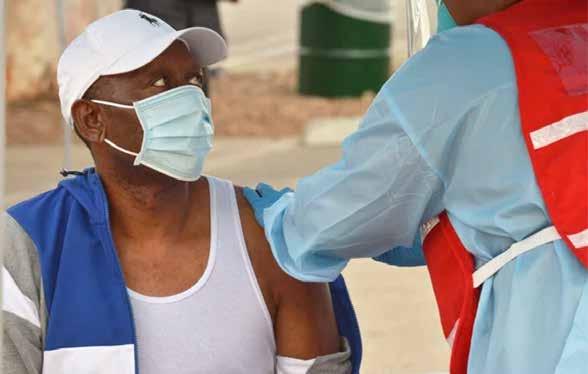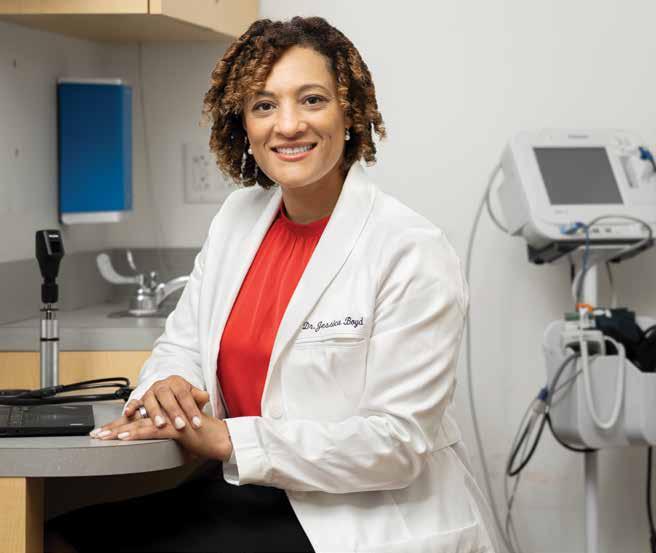
7 minute read
Health
VACCINE UPTICK from Page 18
Black people have received smaller vaccination shares than their shares of cases, deaths and the total population in more than half of states reporting data.
For instance, in the District, Blacks represent 45 percent of those who received at least one dose and make up 56 percent of COVID cases.
African Americans comprise 46 percent of the District’s population but 71 percent of all COVID deaths.
Approximately 49 percent of whites in D.C. have received at least one dose and comprise just 19 percent of COVID cases. Meanwhile, while the District’s white population stands at 41 percent, the death rate from COVID among whites remains 13 percent.
Vaccination rates among African Americans by state continue to raise alarms.
Multiple states, including Vermont, Utah, South Dakota, New Hampshire, Idaho, and Hawaii, report that just 1 percent of their African-American population has received a COVID vaccine.
Alaska, Iowa, Maine, and New Mexico report just 2 percent of their Black population vaccinated.
D.C. at 45 percent, Mississippi at 38 percent and South Carolina at 22 percent, represent the highest number of vaccines among African Americans.
“The reason why Black and Brown Americans had low uptake of vaccines early in the rollout is that they could not get one even if they wanted to,” Dr. Ebony J. Hilton, a critical care anesthesiologist at the University of Virginia and founder of GoodStock Consulting, LLC, tweeted.
Dr. Hilton has denounced things like quick re-openings, anti-vaxxers and reckless gatherings during the pandemic.
“The CDC guidelines were prowhite in design. Prioritization is defined along the lines of age and employment and not risk,” Dr. Hilton wrote.
Dr. Hilton has repeatedly asked the CDC about changing pro-

5 (Courtesy photo)
tocols when it comes to booster shots.
“How are we not repeating this same injustice in the face of racial health disparities as it pertains to boosters? As a result, black Americans die at younger ages, higher rates and have already lost three years of life expectancy,” Dr. Hilton said.
“Race is an independent risk factor,” she declared, adding further that “this will be a stain on the history of America.”
“It is inexcusable, and we, the medical community, and the CDC have to account for our contribution,” Dr. Hilton concluded.
Of individuals who received their first COVID-19 dose since June 1, 39 percent reported that the increase in cases due to the Delta variant was why they got vaccinated.
Thirty-eight percent said they were concerned about the crowding of local hospitals and intensive care units.
In comparison, 36 percent said they knew someone who became seriously ill or died from COVID and 35 percent responded they wanted to participate in activities that require vaccination.
Some still unvaccinated said they don’t believe the vaccines can prevent them from contracting the virus, so why bother? However, medical science shows that while vaccines cannot prevent the virus from entering a person’s body, the shots are designed to help fight off serious illness and death.
Others who oppose the vaccines cite the seemingly rapid development of the doses.
“They weren’t rushed,” former CDC Director Dr. Tom Frieden noted.
“mRNA technology has been researched for more than 20 years. We’re fortunate that it works extraordinarily well for the virus that causes COVID and it may also work for other viruses, such as influenza, in the future,” Dr. Frieden asserted.
“The reason we see alarming rates of hospitalizations and deaths in the U.S. is because many people are still unvaccinated,” he said. “Booster shots may help some people but our biggest challenge is vaccinating those who haven’t gotten their first shot.” WI @StacyBrownMedia
CHASE from Page 15
training and FinTech [financial technology] solutions. Customers, residents and non-profit organizations will have access to free Wi-Fi and community room space.
Brian Atkins, a native and current resident of Ward 8, has been named as the branch’s community manager in a position created to help engage the community and businesses and to increase awareness of resources and tools that will connect residents with financial health education.
Jua Williams, branch manager, is also a Ward 8 resident committed to sharing his knowledge and experience to help others meet their financial goals.
“We’re excited to have state-ofthe-art banking, technology and modern design,” Williams said. “I’m proud of the team we’ve built and together we can help our neighbors imagine a better financial future.”
“We’re moving beyond community banking to community building and are deeply committed to Ward 7 and 8 so that residents can participate in the District’s continued recovery,” Khamla Erskine, Chase’s head of community and business development for Chase Market Expansion, wrote in a press release.
Before cutting the ribbon to officially open the bank, Bowser said, “It’s so important that in every community there are amenities to grow neighborhoods like what’s been happening at Skyland Town Center where new businesses including Roaming Rooster and Half Smoke will also be coming soon.”
“At the end of the day,” Dimon said, “I can make any announcement I want but you have to [ask], ‘How many loans did you make in my neighborhood?’” That’s when people will know how much of a difference we’ve made in this community.”
WI
Pain and Addiction: The Opioid Crisis that Continues to Trend Upwards
Wards 7 & 8 D.C. Prevention Center Hosts Workshop on Opioid Crisis
Natalie C. Hockaday WI Staff Writer
The opioid crisis is ongoing, and D.C. has seen a rise in fatalities over the past few years. The Ward 7 & 8 D.C. Prevention Center hosted a virtual workshop last week over zoom in which healthcare professionals and substance abuse specialists gathered to discuss ways to spread awareness and implement real change in the district to resolve the opioid crisis.
The average number of monthly fatal overdoses in 2019 was 23 but in 2020 it rose to 34. Now, in 2021 the average is 33. The rise in fatal opioid overdoses is in part due to the pandemic, according to Dr. Chikarlo Leak, policy and operations director within the D.C. Office of Racial Equity. Fentanyl, a synthetic opioid has been making its way through drugs and has become responsible for many opioid overdoses. This opioid is similar to morphine, according to National Institute on Drug Abuse experts who said fentanyl is 50 to 100 times more potent.
“One of the key things I like to remember and point out is that these are individuals and loved ones who did not wake up that day. So, their families, their communities, their friends are missing them. So, it’s more than just a number. These are people with individual lives and so we really do as a District have to work hard to reverse this trend,” said Leak.
The ones who are dying the most from these opioid overdoses are Black and male. The most overdoses have taken place with individuals between the ages of 50 and 69. In correlation to this trend most of these overdoses are taking place in Wards 5, 7 and 8.
The city government has tried to resolve the issue of opioid deaths however has fallen short given the rise in deaths over the past few years. Leak says that it has to be more of a collaborative effort beyond just the government and that it “has to be a district-wide kind of approach to reversing this epidemic.
The conversation surrounding addiction widens once examining how racial and socioeconomic factors intersect on this issue. Saleema Snow, a law professor at UDC says this issue stems back decades to former administrations that spearheaded ‘war on drugs’ policies that disproportionately affected Black people. She further states in order to make change, community-based approaches should be implemented with “the community holding people accountable.”
Part of understanding how to treat addiction is understanding how pain is understood and approached when trying to heal it. Pain, Dr. Alka Gupta, Bluerock Primary Care, says is a large problem “because of how multifactorial it is.” As a result of taking a singular approach to solving the problem of pain, alternative methods are overlooked at times that can prevent using such drastic measures, she further explains.
“The opioid crisis stems partially from how we approach treatment of pain sometimes within medicine in an effort to help somebody feel better. Sometimes we look at the short-term picture rather than the long-term picture,” said Dr. Alka Gupta, Bluerock Primary Care.
WI

5 NARCAN is a prescription medication that is used to treat an opioid overdose. (WI File Photo/Shevry Lassiter)
At Unity, you can smoothly schedule a vaccine appointment online at unityhealthcare.org or call 202-469-4699.
Be a hero. Get the shot to protect our people.
Let’s end the COVID-19 pandemic together. Get the shot.






